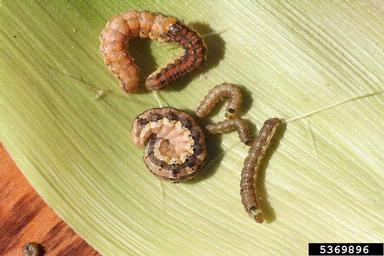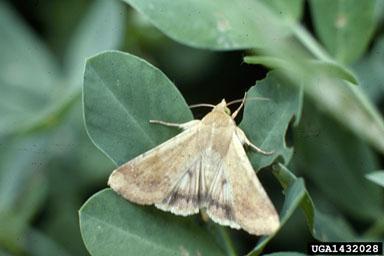Biology
The corn earworm (Helicoverpa zea), also known as the cotton bollworm, soybean podworm, or tomato fruitworm, is the caterpillar of a noctuid moth that occasionally feeds on strawberry fruit in North Carolina. In addition to its namesake plants, it feeds on a wide variety of cultivated crops and weeds. Corn earworms have the same basic egg, larva, pupa, and adult life stages of other moths. Female moths lay eggs singly on suitable host plants. The larvae (caterpillars) feed some on the leaves, but mostly on the developing fruit. Once mature, the larvae tunnel into the soil where they pupate. Caterpillars that mature in the spring and summer emerge as moths the year they were born. Caterpillars that mature in the fall overwinter as pupae in the soil and emerge the following spring.
Corn earworm larvae have a light colored heads and a rough texture due to the presence of microspines along their bodies. They come in a wide variety of colors including yellow, green, and light red, and usually have lateral stripes down the sides of their bodies. Mature caterpillars can grow to be around 1.75 inches long.
Adult corn earworm moths hold their mottled light brown wings in a triangular fashion. Their wingspan is approximately 1 to 1.5 inches wide.
Damage
Damaging population outbreaks in strawberries are most likely to occur during periods of warmer than usual temperatures. Larvae cause damage by chewing large holes into the fruit.
Sampling
In areas where corn earworms have been a problem in the past, pheromone traps can be used to sample for moth activity.
Management Options
Cultural
Soil preparation and fumigation practices common in North Carolina strawberry production destroy most overwintering pupae in the strawberry field. However, moths can migrate in from adjacent fields. Good mowing and weed control practices can reduce the availability of food sources for the larvae.
Conventional Insecticides
Conventional insecticides are available for corn earworm control in strawberries. Some materials available are insect growth regulators (IGR) that work by preventing the caterpillar from developing, not by directly poisoning it. If an IGR is used, it must be timed to egg hatch to be effective. Refer to the North Carolina Agricultural Chemicals Manual for materials recommended for use against corn earworms in North Carolina and the Southern Region Small Fruit Consortium Strawberry IPM Guide for regional recommendations. For other states, check with your local extension agent.
Organic Insecticides
Some formulations of Bt-based insecticides are approved for control of corn earworms in organically-grown strawberries. Refer to the North Carolina Agricultural Chemicals Manual for materials recommended for use against corn earworms in North Carolina and the Southern Region Small Fruit Consortium Strawberry IPM Guide for regional recommendations.
More Information
North Carolina Agricultural Chemicals Manual
Strawberry IPM Guide - Southern Region Small Fruit Consortium
Do it yourself: An update on distinguishing SWD larvae from other insects in strawberries - NC Small Fruit IPM Blog
Corn Earworm in Soybeans - North Carolina Soybean Insect Pests
Publication date: June 23, 2014
N.C. Cooperative Extension prohibits discrimination and harassment regardless of age, color, disability, family and marital status, gender identity, national origin, political beliefs, race, religion, sex (including pregnancy), sexual orientation and veteran status.


